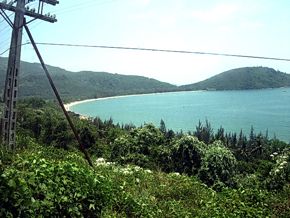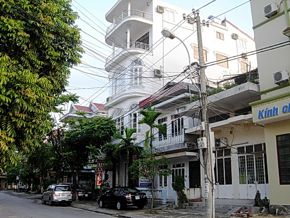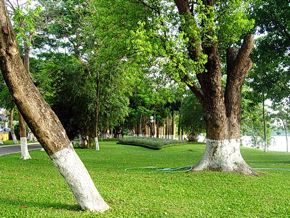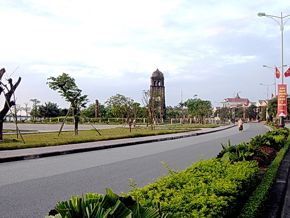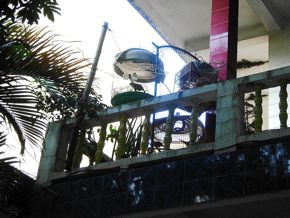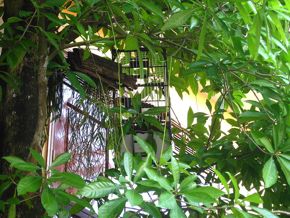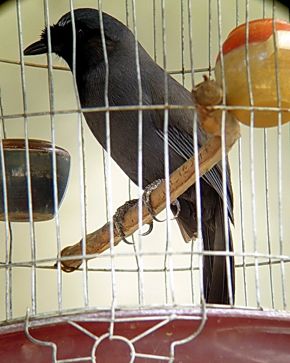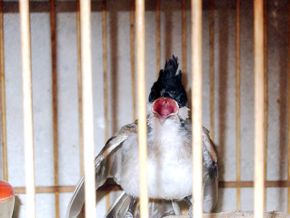“I took the Reunification Express train specifically to view the scenic strip between Danang and Hue along the Vietnamese coast enroute to Dong Hoi. It was my designated stop-off town and for visitors heading for the UNESCO Heritage listed grottos of Phong-Nha and Paradise Caves at Phong Nha-Ke Bang National Park.
Vietnam Coastline with its many scenic bays and inlets do have the makings and potential in the far future of becoming the exuberant and fun living ‘Riviera of the East (below left).
“For now, visitors be content with glossed over brochures and great sea views outside. My experience on my return train journey in May 2013, within … less so (above right).
“Having sat in supposedly ‘best’ soft seat ticket and air-conditioned train for almost eight hours, endured a sauna-bath of its broken air-conditioning system, endured further non-ending thunderbolts of locals’ excitable voices heading for their long, weekend family trips, I was so glad my journey came to end.
“I wasted no time to take a birdy walk at a waterfront, within view from my hotel (below left). There were few birds’ species sighted. Mostly, hardy Eurasian Tree Sparrows (Passer montanus) and a lonely, dull looking White-throated Kingfisher (Halcyon smyrnensis) on a perched branch starring hard into still water.
I noticed all tree trunks grown alongside the wide Nhat Le River had their bases painted white. They were likely impregnated with some form of pesticides to ward off tree destroying borers. The harmful effects I could imagine inadvertently caused sensitive birds to have also stayed away (above right).
“The charred façade, remnant of a church that took a hit during the Vietnam War stood a reminder. The environment, while spruced clean and landscaped, felt sterile with lack lustre feeling of birdlife along the promenade. Unfortunately, it provided no vitality and natural ambiance to the place (below left). I was beginning to have second thoughts about my enthusiasm of this birding trip and thought perhaps, should downgrade my expectations of birds I could see.
“To make the most of my evening at Dong Hoi, I took a stroll behind the hotel to prospect for birds. The location appeared to look like an upper middleclass, up market residential area.
“My evaluation had no less than four houses out of ten in a row having some form of occupied bird cage/s hanging from house balconies, entrances and trees in their compound.
“Here are some discreet, hand-held images of caged birds.
“The Red-whiskered Bulbul (Pyconontus jocosus) being the most popular pet caged bird is almost wiped out in the wild. Only a pair was seen at forest edge in Phong Nha village throughout the duration of my eleven day visit (above right).
“Another house had multiple occupied cages hanging from its balcony. Inside those cages, the silhouettes of R-W Bulbul, White-rumped Sharma (Copsychus malabaricus), a Cuckooshrike species and another obscured bird were identified (below left).
“Knowing that birds are tree-loving creatures, its owner thought best by hanging a birdcage with its pet – a Javan Cuckooshrike (Coracina javensis) in a tree amongst luscious leaves (above right).
“How frustrating it must be for the restless bird as I watched him jumping endlessly in the cage. If only the bird could talk, would say, ‘What is the point of having wings, put me to live in trees but no freedom to even put one toe to touch a stalk of a leaf nor branch?’.
“It is not difficult to do a mathematical calculation to ascertain caged birds in such high percentage of bird pet lovers per household. Assuming an area of 1000 houses, 40% have caged birds say at minimum only one bird each household, these 400 birds being deprived and depraved of reproducing will eventually be depleted of their population growth. Think in millions and what do we have?
“Lifespan of these birds are only several years and they too will die off only to be replaced and eventually with what…? Quality species especially songsters are favourites and they get wiped out quickly. It is already happening at an alarming rate.
“In Phong-Nha village, caged birds are not spared either. Those in business and with a bit more spending power, have caged birds to show.
“Is bird pet ownership a show of financial status…?
“In a small cage, but well supplied with food and water, another all black Cuckooshrike (Coracina) species struggled to come to terms with his fate as a show off house pet (below left).
“In a restaurant, two bird cages occupied by Chinese Hwameis (Leucodioptron canorum) ‘wearing’ white spectacles hung in dining area as mobile ornamental decorations (above right).
“A walk to the edge of village, with permission granted from friendly house owner, pictures were taken of a caged White-crested Laughing Thrush (Garrulax leucolophus). Only one White-crested Laughing Thrush was seen in a small bird wave at the Botanical Gardens, core area of Phong Nha-Ke Bang National Park (below left).
“A well fed caged looking alike Javan Cuckooshrike beside was calling unceasingly (above right).
“Would like readers to think about this distressed, caged chick behind bars that called in vain, got taken away and left its parents to grief their loss (left).
“Is this a decent act of humanity?
” Do join Avian Writer in her next article and ‘birdwalk’ with her to Borneo, Peninsular Malaysia, Indonesian archipelago and Vietnam to view many more situations that warrant readers’ attention and perhaps ignite readers’ passion and advocacy to protect what is left before…. GONE.”
Avian Writer Daisy O’Neill
Penang, Malaysia
14th July 2013
COPYRIGHT ARTICLE AND ALL COPY IMAGES – COURTESY OF DAISY O’NEILL BIRD CONSERVATION


